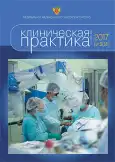REPEAT MYOCARDIAL REVASCULARIZATION IN LONG-TERM PERIOD AFTER PERCUTANEOUS CORONARY INTERVENTION IN PATIENTS WITH CHRONIC OBSTRUCTIVE PULMONARY DISEASE AND STABLE ANGINA PECTORIS
- Authors: Zafiraki VK1, Kosmacheva ED2
-
Affiliations:
- ФГБОУ ВПО Кубанский государственный медицинский университет
- ГБУЗ «НИИ - Краевая клиническая больница №1 им. проф. С.В. Очаповского» МЗ Краснодарского края
- Issue: Vol 8, No 3 (2017)
- Pages: 42-47
- Section: Articles
- URL: https://journals.rcsi.science/clinpractice/article/view/8048
- DOI: https://doi.org/10.17816/clinpract8342-47
- ID: 8048
Cite item
Full Text
Abstract
Full Text
##article.viewOnOriginalSite##About the authors
V K Zafiraki
ФГБОУ ВПО Кубанский государственный медицинский университет
Email: marbach1988@mail.ru
врач-кардиолог, к.м.н. доцент ФГБОУ ВО КубГМУ Минздрава России
E D Kosmacheva
ГБУЗ «НИИ - Краевая клиническая больница №1 им. проф. С.В. Очаповского» МЗ Краснодарского краяпроф., д.м.н., заведующая кафедрой терапии №1 ФПК и ППС ФГБОУ ВО КубГМУ Минздрава России
References
- Enriquez J.R., Parikh S.V., Selzer F. et al. Increased adverse events after percutaneous coronary intervention in patients with COPD: insights from the National Heart, Lung, and Blood Institute dynamic registry. Chest. 2011. Vol. 140, N 3. P. 604-610. doi: 10.1378/chest.10-2644
- Konecny T., Somers K., Orban M. et al. Interactions between COPD and outcomes after percutaneous coronary intervention. Chest. 2010. Vol. 138, N 3.P. 621-627. doi: 10.1378/chest.10-0300.
- Pant S., Deshmukh A., Gurumurthy G.S. et al. Inflammation and atherosclerosis - revisited. J Cardiovasc Pharmacol Ther. 2014. Vol. 19, N 2. P. 170-178. doi: 10.1177/1074248413504994.
- van Diepen J.A., Berbée J.F., Havekes L.M. et al. Interactions between inflammation and lipid metabolism: relevance for efficacy of anti-inflammatory drugs in the treatment of atherosclerosis.Atherosclerosis.2013.Vol.228, N 2. P. 306-315. doi: 10.1016/j.atherosclerosis.2013.02.028.
- Donaldson G.C., Hurst J.R., Smith C.J. et al. Increased risk of myocardial infarction and stroke following exacerbation of COPD. Chest. 2010. Vol. 137, N 5. P. 1091-1097. doi: 10.1378/chest.09-2029.
- Marsch E., Sluimer J.C., Daemen M.J. Hypoxia in atherosclerosis and inflammation. Curr Opin Lipidol. 2013. Vol. 24, N 5. P. 393-400. doi: 10.1097/ MOL.0b013e32836484a4.
Supplementary files






